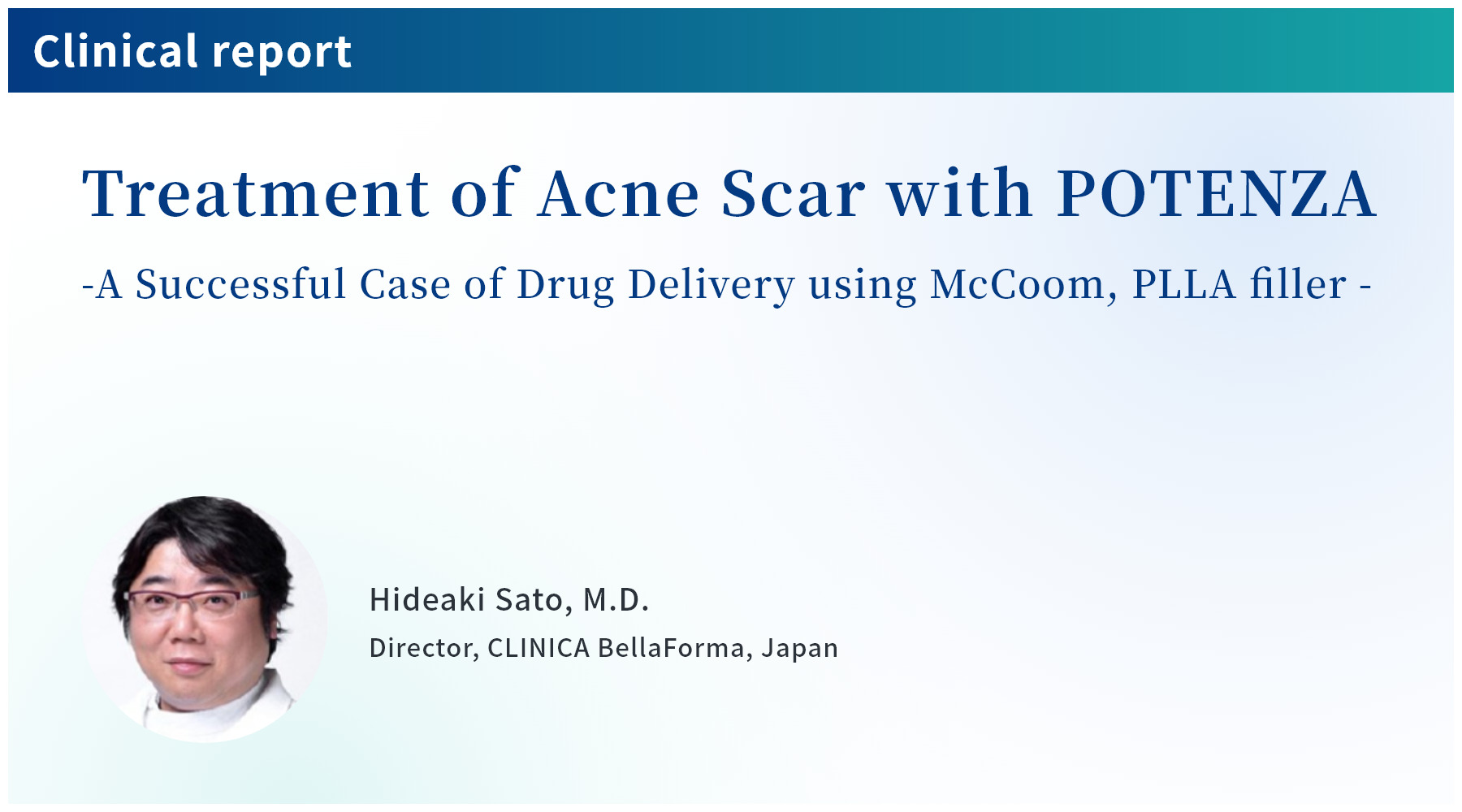Hideaki Sato, M.D.
Director, CLINICA BellaForma, Japan
Introduction
Scarring from acne, a complication of acne vulgaris, causes irreversible morphological changes in the skin, and remains a condition for which there is a significant need for treatment to restore an aesthetically pleasing appearance. However, hypertrophic and depressed scars are particularly difficult to treat, limiting the effectiveness of conventional treatments. Here I present a case of hypertrophic and depressed acne scars successfully treated using the Potenza radiofrequency (RF) fractional microneedling device equipped with a drug delivery system in combination with a Poly-L-lactic-acid (PLLA) filler, called McCoom.
Types of acne scars and conventional treatment
Even after acne vulgaris has been treated, hypertrophic scars, depressed scars, and hyperpigmentation may remain. Among these, hypertrophic scars, in which the affected tissue is elevated, and depressed scars, in which the affected tissue is atrophied, are caused by acne-induced damage to the deep dermis, inhibiting normal tissue regeneration. Depressed scars are classified by shape into an ice pick type (deeply depressed as if pierced with an ice pick), boxcar type (depressed in a square shape), and round type (depressed in a round shape).
The conventional treatments for these acne scars are as follows: microdermabrasion, which involves spraying microscopic metallic particles at high speed onto the skin to exfoliate the entire stratum corneum; physical excision of the scar by transpiration of a large area or portion of the skin using a carbon dioxide or fractional laser; and strong chemical peeling that chemically exfoliates the deep dermis using trichloroacetic acid (TCA) and other chemicals to induce dermal remodeling or injecting filler into depressed portions. Nevertheless, the therapeutic efficacy of these treatments has been limited. In particular, depressed scars have proven to be extremely difficult to treat (Figure 1).
Figure 1: Conventional acne scars treatment

New Treatment – Combination of RF fractional microneedling device and PLLA filler
For the treatment of refractory acne scars, POTENZA, an RF fractional microneedling device, with a drug delivery system and McCoom, PLLA filler (both manufactured by Jeisys Medical Inc.) were used as a combination therapy.
POTENZA is a medical device with a drug delivery system as a standard option that delivers fractional RF through ultra-fine insulated microneedles to target subcutaneous tissue. POTENZA cushion tips (C and CP tips) for the drug delivery system feature a unique pumping function technology that applies negative pressure to suction the skin for uniform puncture during each puncture and positive pressure after RF irradiation for smooth extraction and simultaneous infusion of the drug. This allows the system to deliver the drug more consistently and precisely compared to microneedles and mesotherapy multiinjectors from competitors (Figures 2 and 3).
PLLA filler (McCoom), on the other hand, was developed specifically for POTENZA and uses low-molecular-weight PLLA to reduce the risk of granulomas and other problems. PLLA is a biodegradable polymer that has been widely used in the medical field as a material for dissolvable sutures and bone connecting screws. This material attracts mast cells, mononuclear macrophages, foreign cells after entering the body, and lymphocytes, thereby inducing subcutaneous collagen production during the degradation process that lasts from several months to approximately two years (Figure 4).
Figure 4: Improvement effect by PLLA

Strategies for treating acne scars
The three main efficacy mechanisms are as follows. The treatment aims to improve hypertrophic scars and to restore tissue volume to depressed scar areas.
- Effects of the device: Acceleration of the wound healing process by needle puncture
- Effects of RF: Induction of tissue coagulation and regeneration by monopolar RF irradiation
- Response to PLLA filler: activation of tissue volume augmentation response by PLLA drug delivery
The procedure in the clinical setting (Figure 5) and a typical case of combined therapy with POTENZA and McCoom are shown below.
Figure 5: The treatment in the clinical setting


Discussion and conclusion
Prior to the introduction of POTENZA, clinicians have tried to treat acne scarring with needles, such as microneedles and mesotherapy multi-injectors. However, these methods were not sufficiently effective due to problems with uneven drug delivery and downtime. POTENZA reduces bleeding and downtime by using RF to create a coagulation layer while penetrating deep into the dermis. Moreover, forming a coagulation layer with RF helps ensure reliable drug delivery by preventing any leakage of effusion that could potentially interfere with drug infusion. In summary, the combination therapy with POTENZA and McCoom is useful for treating hypertrophic scars as well as ice pick, boxcar, round depressed scars, and acne scars themselves; therefore, I expect that this new therapy will become the next generation treatment for acne scars.
Jeisys Online Academy Information
You can view this literature as a video on your PC or smartphone.
https://joa.jeisys-inc.com/webinar/63/
